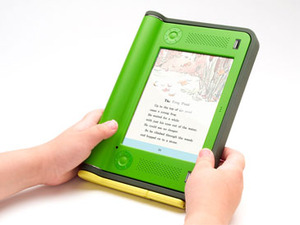
The OLPC Laptop
The last (and most high profile) of the three contenders is the most direct approach to the problem. The project, called One Laptop Per Child (Laptop.org), is spearheaded by Nicholas Negroponte of the Massachusetts Institute of Technology Media Lab. As well as involving some of the MITs best minds, this project has also garnered considerable supporting within the industry, with Google, Red Hat, AMD, Brightstar Corporation, Nortel Networks, News Corporation and Canonical each contributing $2m to development costs. With such prominent web and technology backers on board, the One Laptop Per Child project could hardly ask for any more ringing endorsements, although having Kofi Annan with Nicholas Negroponte to unveil the prototype at the World Summit On The Information Society in 2005 can’t have hurt any.
Some of the high profile sponsors of the OLPC.
So what is at the heart of the OLPC project? Naturally the PC itself. The first and most striking element of the design for a person used to laptops in the Western world is the look of the thing. Bright colours, rounded edges, big buttons, it looks like something you’d expect to see Bob The Builder doing his taxes on. This is because whilst the OLPC project might be industrially staggering in scale and far reaching in its scope, ultimately the aim is to provide laptop computers for children. This is something almost completely unprecedented in the developed world, perhaps because we’re more aware of what the Internet is so often used for.


When closed up in the usual manner, the OLPC is at least partially sealed by a rubber lip around the edge of the display which helps to render it partially waterproof and this, coupled with a sealed rubber keyboard, means that the computer can withstand much more spillage and precipitation than an ordinary laptop, which can usually be put out of action with a poorly aimed cup of coffee. To further toughen up the computer the casing is made out of 2mm thick plastic rather than the 1.3mm used for most laptops and the ports are moulded into the plastic, providing yet more toughness.

MSI MPG Velox 100R Chassis Review
October 14 2021 | 15:04








Want to comment? Please log in.